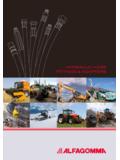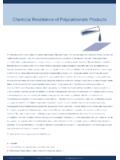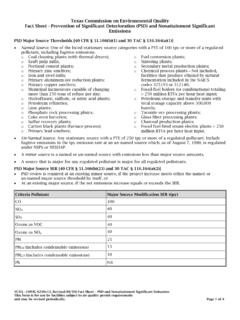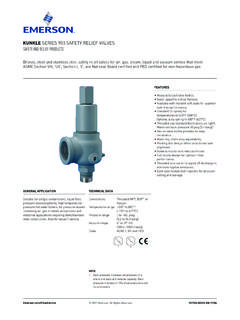Transcription of The Paper Making Process - unizg.hr
1 Obtain a printed version of this brochure from the Idea Exchange at 1 The Paper Making ProcessFrom wood to coated papersappiThe Paper Making Process , the fifth technical brochure from Sappi Idea ExchangeideaexchangeSappi is committed to helping printers and graphic designers use Paper in the best possible way. So we share our knowledgewith customers, providing them with samples, specifications, ideas, technical information and a complete range of brochuresthrough the Sappi Idea Exchange. Find out more on our unique web 1l Introduction2ll Wood production Wood as the raw material3lll pulp productionPulping Process Mechanical and chemical pulp 4 Sulphate and sulphite process4 Intermediate pulp types5 pulp bleaching5lV Paper productionRaw materials Preparation of the fibres in the refiner6 Additional raw materials for the base paper6 Paper machine Suspension at the headbox7 Sheet formation in the wire section7 Filtration / Thickening7 Twinformer and Gapformer8 De-watering in the press section9 Dryer section9 End group9 Surface treatment Size press10 Film press10V Coating The benefits of coated paper11 Coating machine11 Coating preparation12Vl Finishing Calender12 Rewinder13 Slitter rewinder13 Cross cutter13 Guillotine13 Vll Packing
2 And storage 14 VIIIP aper properties15lX Concluding remarks16 The Paper Making ProcessFrom wood to coated paperObtain a printed version of this brochure from the Idea Exchange at l IntroductionThough we may take it for granted, Paper is always with us,documenting our world and reminding us of the limitlesspossibilities of life. Invented by the Chinese 2,000 years ago, Paper has been used ever since as a communication , Paper was made out of fibres from mulberry bark,papyrus, straw or cotton. Wood only emerged as the chiefraw material for Paper mass production as recently as themid 19th printed page is immediate, its message cutting acrosscultures; a tactile experience that demands attention andcreates desire. It is a passport to knowledge, a storagemedium, a persuasive tool and an entertaining art is a sustainable resource and a permanent docu-ment.
3 It is the universal medium on which we chronicle ourevery-day history. Paper carries the past. It is the canvas onwhich we live the present and the blueprint upon which wedesign our touches the lives of every individual on this planet,and at Sappi, we never stop thinking about this fact. We areproud that Sappi is the largest and most successful producerof coated fine papers in the world. At Sappi, we are relent-lessly developing new standards for the Paper on centuries of experience, and the craftsmanshipand expertise of its own people supported by 21st centurypapermaking technology, Sappi will lead the industry toensure that this creative communication medium, Paper , isthe best it can be! This brochure shows how we make this first class with the production of the most important rawmaterial, wood.
4 The pulping Process converts this woodinto the most appropriate type of pulp . The Paper machinethen converts the pulp into a thin base Paper , which, at theend of the production Process , is coated to give it a superbflat surface and bright shade. Following the description ofthis Process , we will take a look at the properties used tomeasurethe quality of Paper . The interior of a historical Paper millObtain a printed version of this brochure from the Idea Exchange at Wood productionWood as the raw materialApproximately 25,000 plants with a woody stem are registeredunder the term wood. However, the different varieties clearlydiffer in terms of usability for the production of are preferred as the fibres are longer than, for example,fibres of deciduous trees.
5 Longer fibres form a firmer fibrousweb and, hence, a firmer Paper on the Paper machine. Conifers used are mainly spruce, fir and pine, whereasbeech, birch, poplar and eucalyptus are the most importantdeciduous varieties used for Paper . A trunk of a tree is not a homogeneous body composed ofidentical cells. The cells differ according to type, age, seasonof origination and arrangement in the trunk. At the outside,there is the bark, below are the bast and the cambium,which form the growth tissue. By cell division, the cambiumgrows out from the centre of the tree. Growth stagnationduring the winter months results in the annual rings. Thetrunk with its different cells which are responsible for thetransport of the nutrients and the saps can be used forpaper pulp , but not the means that the wood supplied to the Paper mill has tobe debarked before it can be used to produce one of thevarieties of pulp the base material for the production ofpaper.
6 The debarked trunks are either pulped to fibres(mechanical wood pulp ) or processed to chips for wood finds it way directly to the Paper mill in the form oftrunks or in the form of timber mill waste (slabs, chips).Wood trunksChipsBeech trunks Obtain a printed version of this brochure from the Idea Exchange at pulp productionPulping processPulping of wood can be done in two ways: mechanically pulpIn the case of mechanical pulp , the wood is processed intofibre form by grinding it against a quickly rotating stone underaddition of water. The yield* of this pulp amounts to The result is called wood pulp or MP mechanical disadvantage of this type of pulp is that the fibre isstrongly damaged and that there are all sorts of impurities inthe pulp mass.
7 Mechanical wood pulp yields a high opacity,but it is not very strong. It has a yellowish colour and low pulpFor the production of wood pulp , the pure fibre has to be setfree, which means that the lignin has to be removed as achieve this, the wood chips are cooked in a case of wood pulp obtained by means of chemicalpulping, we differentiate between sulphate and sulphitepulp, depending on the chemicals used. The yield of chemicalpulping amounts to approximately 50%. The fibres in theresulting pulp are very clean and undamaged. The woodpulp produced by this Process is called woodfree. It is thistype of pulp which is used for all Sappi fine sulphate processis an alkaline Process . It allows for theprocessing of strongly resinous wood types, but this requiresexpensive installations and intensive use of sulphite processutilises a cooking acid consisting ofa combination of free sulphur acid and sulphur acid boundas magnesium bi-sulphite (magnesium bi-sulphite Process ).
8 In the sulphite Process , the cooking liquid penetrates thewood in the longitudinal direction of the fibres, which arealigned in this same longitudinal direction in the chips. Whenthe cooking liquid penetrates the wood, it decomposes thelignin, which, during the actual cooking Process , is convertedinto a water-soluble substance that can be washed out. Thedecomposition products of the carbohydrates are includedin the cooking liquid as the waste fluids are concentrated in order to recyclethe chemicals, these sugars are processed to alcohol andethanoic acid. In this stage, the sulphite pulp is slightlybrown and therefore has to be bleached to obtain a basecolour suitable for white papers. This bleaching Process , inwhich no chlorine or chlorine compounds are used, alsotakes place in the pulp mill as an integrated part of the over-all strength of sulphite pulps is less than that of sulphatepulps.
9 Sappi uses only the magnesium bi-sulphite processin its own pulp Pulpyield 90-96%TMPT hermo-Mechanical-Pulpyield 90-96%CTMPC hemi-Thermo-Mechanical-Pulpyield 85-90%Sulfate Process (alkali)yield 43-52%Sulphite Process (acid)yield 43-52 %Pulping processMechanicalThermo-mechanicalChemic al-thermo-mechanicalChemical* yield = usable part of the woodObtain a printed version of this brochure from the Idea Exchange at bleachingInitially, wood pulp has a brown or brownish colour. To obtainthe brightness required for white papers, it has to be this Process of bleaching, the remaining lignin isremoved as well. In practical terms, bleaching is a continuationof the chemical cooking Process , taking place directly after-ward in the pulp mill as an integrated next step of the overallprocedure.
10 Bleaching is a complex Process , consisting ofseveral chemical Process steps, with washing taking placebetween the various chemical wood pulp can be bleached with chlorine / chlorinecompounds, ozone / oxygen in different forms as well ashydrogen on the negative impact of some chlorine containingdecomposition products, there are, however, environmentalobjections against the use of chlorine and chlorine this reason, Sappi has long ago switched to chlorine-free processes are referred to as Totally Chlorine Free(TCF).From the unbleached to the bleached pulpIntermediate pulp types:TMPT hermo Mechanical pulp In this procedure, chopped waste wood is vaporisedand then beaten into single fibres in refiners undervapour Mechanical pulp (wood pulp )This Process consists of a combination ofimpregnation (mixing with a chemical pulp ), cooking,refining and bleaching.





